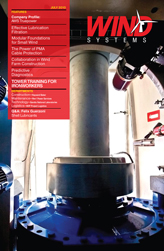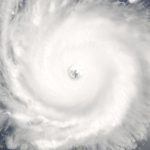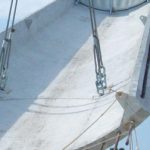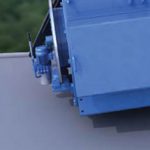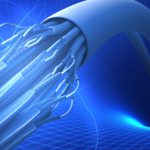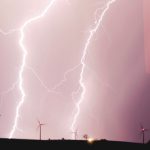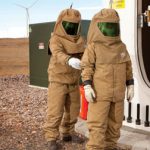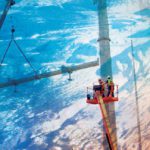At sea there is significantly more wind than on land. That means the installation is constantly in motion so that torsion in cables, vibration, and points of abrasion can occur. The cables must be protected, naturally, so the cable protection products from PMA are employed. In system construction there is successively less space available for electrical components. Cramped cable ducts, junction boxes full to the bursting point, and extensive EMC protection elements (e.g. EMC shielding) can cause cables and wiring to experience abrasion or chaffing on the edges of electrical components, cabinets, etc., above all when vibration and permanent movement are involved. Cable protection is therefore necessary.
Polyamide Cable Protection
The PMA conduit PCS was specially developed for external applications exposed to high mechanical stress. The conduit is very flexible, allowing it to be formed around sharp angles and curves.
Additionally, metal conduits must be sawn to length, whereas the polyamide conduits can in next to no time be trimmed to the correct length with a pair of scissors or a pocket knife. It is manufactured from specially modified PA12 raw material supplemented by additives to improve the already excellent weathering resistance of the PA12 material. This provides a life expectancy in predominantly static applications such as those in excess of 25 years. PCS also has very good low temperature characteristics, which is very important because the system is exposed to the elements in summer and winter. Polyamide is hygroscopic, absorbing and giving up water to the surrounding air depending upon the humidity. With PA12 this effect is less pronounced, ensuring that even with low humidity the material retains very good impact resistance.
In order to produce the right product for the right application it takes a state of the art production facility that carries out intensive R&D activities using the latest production technologies. Intensive research and development also consist of intensive product testing, which includes dynamic reverse bending, impact strength, compression strength, system pull-out strength, peak load, self-extinguishing flammability resistance, thermal aging, and cold bending, etc. Not only is the test important, so are the test methods themselves.
Test methods consist of Reversed Bending Test with Swinging Movements. This standard is based on a cyclic reversed bending test (pivoting) of conduits under various conditions (temperature). The conduits are dynamically loaded and evaluated at the upper and lower application temperature limits. The test is performed based on IEC EN 61386. The minimum requirement corresponds to the specifications of IEC EN 61386. For PMA, the test is not considered completed for final evaluation until cracking or fracture. The number of cycles to fracture determines the fatigue strength of the conduit.
The next test is Reversed Bending Test. This standard describes a cyclic reversed bending test with additional tensile loading (lifting) on flexible conduits under standard ambient conditions (23°C/73°F @ 50 percent relative humidity). The conduit is loaded until fracture. The number of cycles to fracture determines the fatigue strength of the conduit. In addition to the lifting reversed bending test there is a Rotation or Oval Reversed Bending Test. This standard describes a cyclic bending test (rotation in an oval pattern) on flexible conduits under standard ambient conditions (23°/73°F @ 50 percent relative humidity). The conduit is tested until failure. The number of cycles to fracture determines the fatigue strength of the conduit. Figure 1
The next test is Peak Load Test. This standard describes the peak load test on conduits under standard ambient conditions (23°C/73°F @ 50 percent relative humidity). The conduit is deformed by a defined amount between two plates. The restoring force established over a specific time by relaxation of the conduit describes the crushing pressure or compression strength.
A Pull-Out Test defines the system pull-out test on conduits and connectors under standard ambient conditions (23°C/73°F @ 50 percent relative humidity). The conduits are mounted with the appropriate system connectors. The pull-out strength of the system is determined in a tensile test.
Next is the Impact Test. This standard describes the impact strength test on conduits at various temperatures. The conduit sample is placed on a steel plate and centered under an impact head with a defined profile. The impact head impacts the center of the conduit surface. In contrast to international specifications, deformation behavior (buckling) is determined rather than fracture behavior. The impact test has been passed if no fracture or cracking can be detected after the impact, as well as no excessive permanent deformation of the conduit in accordance with PMA specifications.
A Cold Bending Test describes one performed on conduits at low temperatures. The conduits are stored in a controlled climate cabinet at the specified test temperature. Loading is achieved by winding the conduit around a test mandrel with a defined diameter. The various products are classified based on the mandrel diameter that can be achieved.
Thermal Aging Tests are used on thermally aged conduits. The test conduits are stored in a controlled climate oven at the specified test temperature. After removal from the oven they are cooled to room temperature. Loading is achieved by winding the conduit around a test mandrel with a defined diameter. The various products are classified based on the mandrel diameter that can be achieved.
One of the final tests is known as Self Extinguishing. This standard describes a flame test on conduits based on international specifications. The conduit is exposed to a defined flame from a standard burner. The time of ignition and flame propagation behavior—as well as time of extinguishing after removal of the flame source—are significant parameters for evaluating the flame behavior of the products. Figure 2
In addition to R&D, PMA products need to conform to worldwide standards and regulations. As a pioneer in the field of cable protection, PMA has always given high priority to our own testing facilities and have consciously introduces stringent in-house standards as described previously. This approach has enabled PMA to exercise a significant influence on the development of international standards. Standard committees with responsibility for cable protection systems regularly ask our company to provide advice or participate as an active member.
Armed Against the Elements
A failure in the electronic monitoring system of a wind energy plant can have fatal consequences. PMA specialists for high quality cable protections systems have designed a simple but effective component, manufactured from specially formulated polyamide, which can be applied in addition to a standard lock nut on the thread of a fitting, increasing the outlet radius and thus preventing potential abrasion damage caused by tight bending radii and vibration. The anti-abrasion lock nut is available in a divisible form for retrofit applications or as a one-piece element for applications in new designs from conception onwards.
Cable protection can generally be seen as a dispensable element. If a cable is laid without a conduit around it, it is exposed to the prevailing environmental conditions around it. Cable protection is used to protect the cables from external factors. That means that if through a particularly inauspicious collection of circumstances or some extraordinary mechanical stress damage occurs, it is “only” the cable protection that is damaged and the cable function is not affected. The cable protection may be replaced.
Through the excellent basic characteristics of the specially modified polyamide 12 material used for PCS, this conduit type is particularly suitable for use in applications that are permanently exposed to intensive sunlight (UV). Additionally, PCS possesses very good resistance to chemicals. Given that for an average installation of 100 measuring points with three components each to be installed, the time saved can add up to between 20 and 50 hours comparing the polyamide system with conventional protection using armored metal pipes. Figure 3
For the installation at Alpha Ventas wind park there was no specific requirements placed upon the cable protection system from the wind energy segment regarding certification. The PCS product being used there possesses all relevant certificates for worldwide applications in the highest safety categories.
Being an installation at sea, and having the same needs and requirements as the marine industry, the use of PCS and other PMA products are approved for the shipping industry by Bureau Veritas, Det Norske Veritasl and Lloyds Register. In addition to these approvals PMA products are also approved by UL and CSA for installations in the United States and Canada.
Wind turbine systems are a network made up of motors, controls, lighting, sensors, and numerous devices located throughout the tower, nacelle, and hub. If any one of these devises fails due to damaged cables, costly repairs and service are inevitable. As Hoger Stoven says, “In wind energy installations, particularly offshore, cable protection is indispensable. The products from PMA offer everything today which is necessary for correct cable protection.”



















